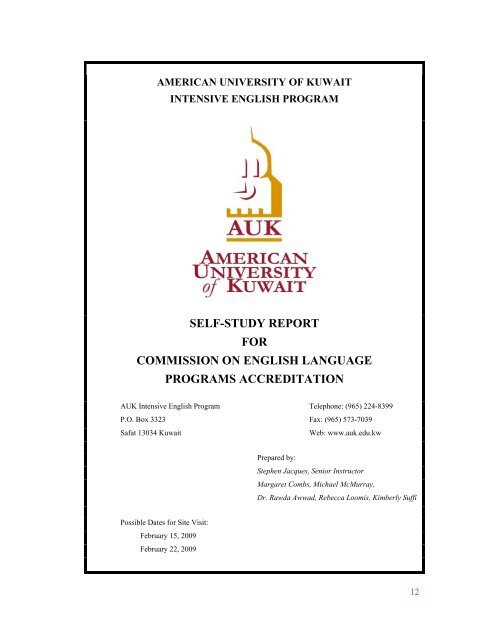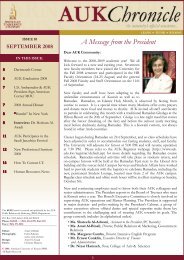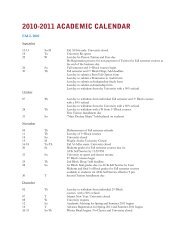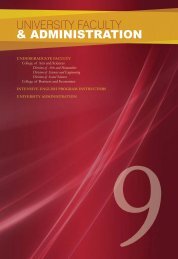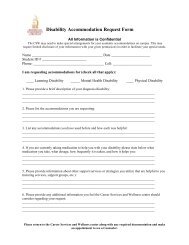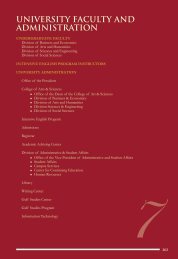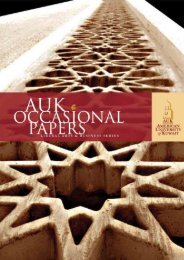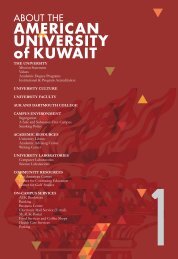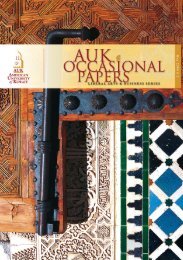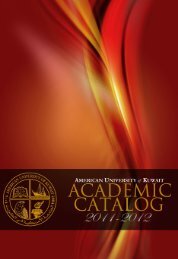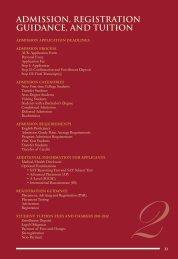self-study report for commission on english language ... - AUK
self-study report for commission on english language ... - AUK
self-study report for commission on english language ... - AUK
- No tags were found...
You also want an ePaper? Increase the reach of your titles
YUMPU automatically turns print PDFs into web optimized ePapers that Google loves.
AMERICAN UNIVERSITY OF KUWAITINTENSIVE ENGLISH PROGRAMSELF-STUDY REPORTFORCOMMISSION ON ENGLISH LANGUAGEPROGRAMS ACCREDITATION<strong>AUK</strong> Intensive English Program Teleph<strong>on</strong>e: (965) 224-8399P.O. Box 3323 Fax: (965) 573-7039Safat 13034 KuwaitWeb: www.auk.edu.kwPrepared by:Stephen Jacques, Senior InstructorMargaret Combs, Michael McMurray,Dr. Rawda Awwad, Rebecca Loomis, Kimberly SuffiPossible Dates <str<strong>on</strong>g>for</str<strong>on</strong>g> Site Visit:February 15, 2009February 22, 200912
I. INTRODUCTIONA. Organizati<strong>on</strong>al Overview and History of ProgramThe Intensive English Program (IEP) was developed structurally, academically, andphilosophically in tandem with the American University of Kuwait (<strong>AUK</strong>). Since theuniversity’s incepti<strong>on</strong>, c<strong>on</strong>versati<strong>on</strong>s relative to the IEP were integral in all universityplanning meetings and development activities that occurred during the start-up phase of theUniversity. In June 2003, the Director of the Intensive English Program, Ms. MargaretCombs, was hired by <strong>AUK</strong> and was given the resp<strong>on</strong>sibility <str<strong>on</strong>g>for</str<strong>on</strong>g> developing the blueprint <str<strong>on</strong>g>for</str<strong>on</strong>g>an IEP immediately. Such a blueprint was presented in June 2004 and adjusted according tothe strategic start-up planning criteria. The initial implementati<strong>on</strong> phase of the IEP tookplace between March 2004 and September 2004, the date of operati<strong>on</strong>s and included: 1. Thec<strong>on</strong>structi<strong>on</strong> of appropriate IEP facilities that included technology based classrooms andwriting laboratories, curriculum, courses, and syllabi; 2. Research based adopti<strong>on</strong> ofinstructi<strong>on</strong>al materials, <strong>language</strong> placement tests, assessments; 3. Integrati<strong>on</strong> of the relevantIEP data into the Banner—the computerized student management system adopted by theuniversity.Since operati<strong>on</strong>s began <strong>on</strong> September 14, 2004, the IEP initiated, developed, andimplemented strategic initiatives based <strong>on</strong> the initial student per<str<strong>on</strong>g>for</str<strong>on</strong>g>mance, student needs,increase in student enrollment, increase in faculty hiring, and expansi<strong>on</strong> of program. Theevolving expectati<strong>on</strong>s and student learning outcomes at the University’s undergraduate level,by default required an equally evolving IEP that extended the University’s visi<strong>on</strong> andaccurately resp<strong>on</strong>ded to its own interdependent missi<strong>on</strong> and goals.Thus, all areas addressed in the ten (10) standards of the <str<strong>on</strong>g>self</str<strong>on</strong>g>-<str<strong>on</strong>g>study</str<strong>on</strong>g> evolved over the course ofthe first (4) years of the start-up phase of the program and the University. What follows is asummary that captures the horiz<strong>on</strong>tal and lateral developments of the IEP as it operates bothas a distinct University unit and as an integrative unit that dovetails the University’s missi<strong>on</strong>and goals.Development of the Missi<strong>on</strong> StatementThe missi<strong>on</strong> statement of the IEP has evolved over the course of the first four (4) years of theUniversity’s start-up. The missi<strong>on</strong> of the IEP is integrally linked to the missi<strong>on</strong> of theUniversity and thus revisi<strong>on</strong>s and adjustments to the University’s missi<strong>on</strong> by default initiatedrevisi<strong>on</strong>s and adjustment to the IEP missi<strong>on</strong>. Regardless of the revisi<strong>on</strong>s, however, the coremissi<strong>on</strong> of the IEP relative to the preparedness level of the student’s <strong>language</strong> proficiency and<strong>language</strong> preparedness to the University’s undergraduate program remained c<strong>on</strong>stant.Time line ofDevelopment &Revisi<strong>on</strong>s, &foundersUniversity’s missi<strong>on</strong>statement developedJune 2004 by Dr.Samih Farsoun, Deanof Liberal Arts andSciences; approvedby Executive Board.IEP’s missi<strong>on</strong>statement developedby Margaret Combs,Director of the IEPand Senior start-upadministrators,approved by theUniversity’s Missi<strong>on</strong> StatementThe American University of Kuwait isa liberal arts instituti<strong>on</strong> based <strong>on</strong> theAmerican model of higher educati<strong>on</strong>.It is dedicated to providing studentswith knowledge, <str<strong>on</strong>g>self</str<strong>on</strong>g>-awareness, andpers<strong>on</strong>al growth experiences that canenhance critical thinking, effectivecommunicati<strong>on</strong>, and respect <str<strong>on</strong>g>for</str<strong>on</strong>g>diversity. <strong>AUK</strong> seeks to create leadersand lifel<strong>on</strong>g learners who aspire to thehighest standards of moral and ethicalresp<strong>on</strong>sibility in their societies.IEP’s Missi<strong>on</strong> StatementThe missi<strong>on</strong> of the Intensive English Program isto prepare students to gain sufficient mastery ofthe English <strong>language</strong> in order to enter the degreeprograms of the University and to excel asstudents. The purpose of the Intensive Englishprogram is to train n<strong>on</strong>-native speakers in specificuses of English <str<strong>on</strong>g>for</str<strong>on</strong>g> academic purposes, as well asto provide quality English <strong>language</strong> instructi<strong>on</strong> toall individuals who have chosen English as theirmedium of communicati<strong>on</strong> <str<strong>on</strong>g>for</str<strong>on</strong>g> academic pursuitsand to promote internati<strong>on</strong>al and interculturalunderstanding.13
Executive Board July2004.University’s missi<strong>on</strong>statement revised byDr. MarinaTolmacheva,President and theBoard of Trustees,and approved byExecutive Board inSpring 2006.IEP’s missi<strong>on</strong>statement revised bythe IEP, andapproved by thePresident’s Cabinet inFall 2007.The American University of Kuwait isa liberal arts instituti<strong>on</strong> based <strong>on</strong> theAmerican model of higher educati<strong>on</strong>.It is dedicated to providing studentswith knowledge, <str<strong>on</strong>g>self</str<strong>on</strong>g>-awareness, andpers<strong>on</strong>al growth experiences that canenhance critical thinking, effectivecommunicati<strong>on</strong>, and respect <str<strong>on</strong>g>for</str<strong>on</strong>g>diversity. <strong>AUK</strong> seeks to create leadersand lifel<strong>on</strong>g learners who aspire to thehighest standards of moral and ethicalresp<strong>on</strong>sibilities in their societies.The missi<strong>on</strong> of the American University ofKuwait Intensive English Program is to preparestudents seeking admissi<strong>on</strong> to enter the academicdegree programs of <strong>AUK</strong>, by enabling them togain sufficient mastery of the English Languageand successfully apply the critical thinking skillsthey need to excel as students both during andafter their <str<strong>on</strong>g>for</str<strong>on</strong>g>mal studies. IEP will achieve itsmissi<strong>on</strong> by training n<strong>on</strong>-native English speakersin specific uses of English <str<strong>on</strong>g>for</str<strong>on</strong>g> academic purposes,by providing quality English <strong>language</strong> instructi<strong>on</strong>to all who have chosen English as their mediumof communicati<strong>on</strong> <str<strong>on</strong>g>for</str<strong>on</strong>g> academic pursuits and bypromoting internati<strong>on</strong>al, intercultural and <str<strong>on</strong>g>self</str<strong>on</strong>g>understanding.Development of the Organizati<strong>on</strong>al StructureThe initial organizati<strong>on</strong>al structure was put into place in Fall 2004. The Director of IEP<str<strong>on</strong>g>report</str<strong>on</strong>g>ed directly to the University’s Dean of Academic Affairs, Dr. Samih Farsoun. Theprogram was composed of the Director, <strong>on</strong>e (1) Laboratory Assistant, and faculty. TheLaboratory Assistant and faculty <str<strong>on</strong>g>report</str<strong>on</strong>g>ed directly to the Director of the IEP. In Spring 2006,the Director of the IEP began to <str<strong>on</strong>g>report</str<strong>on</strong>g> directly to the President of the University. The shift inthe organizati<strong>on</strong>al <str<strong>on</strong>g>report</str<strong>on</strong>g>ing structure was a direct result of several administrative changes atthe University level. The positi<strong>on</strong> of Dean of Academic Affairs become vacant, thus<str<strong>on</strong>g>report</str<strong>on</strong>g>ing structure of the IEP was directed to the President.In Spring 2006, we determined the need <str<strong>on</strong>g>for</str<strong>on</strong>g> two coordinator positi<strong>on</strong>s thus these positi<strong>on</strong>swere created and filled by Spring 2007. The Assistant to the Director of the IEP positi<strong>on</strong> wascreated and filled by Spring 2007. The academic supervisory resp<strong>on</strong>sibilities have evolvedover the course of the 2007/2008 academic year. Initially, Coordinator I was resp<strong>on</strong>sible <str<strong>on</strong>g>for</str<strong>on</strong>g>ENGL 099 and the reading and writing comp<strong>on</strong>ent of IENG Level 3, and Coordinator II wasresp<strong>on</strong>sible <str<strong>on</strong>g>for</str<strong>on</strong>g> Oral Communicati<strong>on</strong> <str<strong>on</strong>g>for</str<strong>on</strong>g> IENG Levels 1, 2 & 3, and <str<strong>on</strong>g>for</str<strong>on</strong>g> the reading andwriting comp<strong>on</strong>ent <str<strong>on</strong>g>for</str<strong>on</strong>g> IENG levels 1 & 2. Beginning in Fall 2008, the resp<strong>on</strong>sibilities of thecoordinators were adjusted: Coordinator 1 is resp<strong>on</strong>sible <str<strong>on</strong>g>for</str<strong>on</strong>g> English 099, and Reading andWriting <str<strong>on</strong>g>for</str<strong>on</strong>g> IENG levels 1, 2 & 3, and Coordinator II is resp<strong>on</strong>sible <str<strong>on</strong>g>for</str<strong>on</strong>g> Oral Communicati<strong>on</strong>s<str<strong>on</strong>g>for</str<strong>on</strong>g> IENG levels 1, 2, & 3. During the history of the IEP, student workers were hired.Currently eight (8) student workers are working <str<strong>on</strong>g>for</str<strong>on</strong>g> the IEP and <str<strong>on</strong>g>report</str<strong>on</strong>g> directly to theAssistant to the Director. Since operati<strong>on</strong>s, IEP faculty increased by approximately 200%.At the beginning of operati<strong>on</strong>s, the number of full-time IEP instructors was 11, and <strong>on</strong>e witha half time positi<strong>on</strong> and the Director with a half-time positi<strong>on</strong>. To date, the number of fulltimeIEP instructors is 21, and the number of part-time instructors is approximately 2-3 persemester. The IEP loses approximately 1.5 faculty members per year, of which 50% areterminated <str<strong>on</strong>g>for</str<strong>on</strong>g> cause and the remaining 50% are at will of the faculty member.Historical Highlights of the IEPThe following is a summary of key events that have shaped the IEP <strong>on</strong> organizati<strong>on</strong>al,academic, and philosophical levels:September 2003• Physical move of start-up from its temporary office located at the American School ofKuwait (ASK) to the current <strong>AUK</strong> campus.14
• Development of the IEP Missi<strong>on</strong> Statement by the Director of the IEP, MargaretCombs, and the senior start-up administrators, and approved by the Executive Board.• Development of the IEP curriculum <str<strong>on</strong>g>for</str<strong>on</strong>g> all three levels by the Director of the IEP,Margaret Combs.August 2004• Completi<strong>on</strong> of hiring of <strong>AUK</strong>’s IEP faculty, and arrival of faculty <strong>on</strong> campus inpreparati<strong>on</strong> <str<strong>on</strong>g>for</str<strong>on</strong>g> classes.September 2004• Development of Level 3 syllabus by Michael McMurray, Catherine Warner-Bennani,Linda Raye Sue, Pauline Arthur and David Hart.• Development of Level 2 syllabus by Alis<strong>on</strong> Koushki and Rebecca Sanchez-Loomis<strong>AUK</strong>.• Development of Level 1 syllabus by D<strong>on</strong> Prades.• Commencement of <strong>AUK</strong> operati<strong>on</strong>s, first semester, <strong>on</strong> September 14, 2008.C<strong>on</strong>sequently IEP commences its classes.Spring 2005• Changes and revisi<strong>on</strong>s to the curriculum <str<strong>on</strong>g>for</str<strong>on</strong>g> IEP classes were submitted at the end ofthe Spring semester by the following IEP faculty members:Michael McMurray <str<strong>on</strong>g>for</str<strong>on</strong>g> Level 3.Rebecca Sanchez-Loomis <str<strong>on</strong>g>for</str<strong>on</strong>g> Level 2.D<strong>on</strong> Prades and Stephen Jacques <str<strong>on</strong>g>for</str<strong>on</strong>g> Level 1.Summer 2005• Development of the Bridge Program by Margaret Combs and Dr. Rawda Awwad,Freshman Writing Coordinator, which was completed in the Spring semester.• Penguin Readers are introduced into IEP.Fall 2005• Implementati<strong>on</strong> of the new IEP attendance policy.• University decisi<strong>on</strong> to disc<strong>on</strong>tinue the C- grade initiated changes <str<strong>on</strong>g>for</str<strong>on</strong>g> letter grades inthe IEP.• Introducti<strong>on</strong> of the Criteri<strong>on</strong> Writing Program to the IEP.• Incepti<strong>on</strong> of L<strong>on</strong>gman Interactive English Software with IEP labs.• Implementati<strong>on</strong> of The ACCUPLACER OnLine Exit exam as part of the students’overall grade; ACCUPLACER OnLine was no l<strong>on</strong>ger used merely as a proficiencyexam to assess students’ ability.• Integrati<strong>on</strong> of the Reading Circles into the IEP lab comp<strong>on</strong>ent in order to encouragereading.• Participati<strong>on</strong> of IEP students in the first <strong>AUK</strong> Academic Showcase.Spring 2006• Commissi<strong>on</strong>ing of Rebecca Sanchez-Loomis to c<strong>on</strong>tinue developing the Bridgeprogram. Promoti<strong>on</strong> of Rebecca Sanchez-Loomis to Curriculum Coordinator.• Implementati<strong>on</strong> of new strategies <str<strong>on</strong>g>for</str<strong>on</strong>g> IEP student recruitment.Fall 2006• Hiring of two additi<strong>on</strong>al full time and two adjunct IEP instructors, increasing facultyto 16 instructors.• Commencement of the Bridge Program structured up<strong>on</strong> three different levels in orderto assist students in making an easier transiti<strong>on</strong> from IEP or high school into ENGL15
090 or ENGL 101. The three levels were defined as ENGL 085, ENGL 086 andENGL 087. These courses were half a semester l<strong>on</strong>g or <strong>on</strong>e block.Spring 2007• Disc<strong>on</strong>tinuati<strong>on</strong> of the Bridge Program due to Kuwait Ministry regulati<strong>on</strong>s.Government regulati<strong>on</strong>s c<strong>on</strong>cerning scholarships created problems with students <strong>on</strong>scholarship in the Bridge Program.• Implementati<strong>on</strong> of English 099 to replace the Bridge Program. This course wasdesigned to provide students with the skills needed <str<strong>on</strong>g>for</str<strong>on</strong>g> writing academic papers <str<strong>on</strong>g>for</str<strong>on</strong>g>the undergraduate programs.• Hiring of three additi<strong>on</strong>al instructors to meet the demands of English 099.• Standardizati<strong>on</strong> of more rigid essay writing through the use of portfolio assessed by aportfolio committee in the ENGL 099 program.• Promoti<strong>on</strong>s of IEP faculty: D<strong>on</strong> Prades and John Barnett promoted to SeniorInstructors and Rebecca Sanchez-Loomis promoted to Curriculum Coordinator.Summer 2007• Standardizati<strong>on</strong> of more rigid IEP Oral Communicati<strong>on</strong> presentati<strong>on</strong>s begins <str<strong>on</strong>g>for</str<strong>on</strong>g> allthree levels. Stephen Jacques was resp<strong>on</strong>sible <str<strong>on</strong>g>for</str<strong>on</strong>g> developing the rubrics andpresentati<strong>on</strong> goals <str<strong>on</strong>g>for</str<strong>on</strong>g> all three IEP Oral Communicati<strong>on</strong> levels as well as handoutsand instructi<strong>on</strong>s <str<strong>on</strong>g>for</str<strong>on</strong>g> IENG 020 and IENG 030. D<strong>on</strong> Prades developed handout andinstructi<strong>on</strong>s <str<strong>on</strong>g>for</str<strong>on</strong>g> IENG 010.• Applicati<strong>on</strong> <str<strong>on</strong>g>for</str<strong>on</strong>g> CEA candidacy by Margaret Combs <strong>on</strong> behalf of the IEP.Fall 2007• Attendance of Margaret Combs and Stephen Jacques at the CEA Self-StudyAccreditati<strong>on</strong> workshop in America.• Nominati<strong>on</strong> of Committee members and submissi<strong>on</strong> of the Self-Study Plan to CEA inAmerica.Spring 2008• Approval and commencement of the Self-Study Plan.• Revisi<strong>on</strong>s to current IEP curriculum were c<strong>on</strong>ducted.Fall 2008• Commencement of <str<strong>on</strong>g>for</str<strong>on</strong>g>mal Curriculum Review Committee• Nominati<strong>on</strong> of IEP faculty representative.• Implementati<strong>on</strong> of revised curriculum <str<strong>on</strong>g>for</str<strong>on</strong>g> the Reading and Writing Comp<strong>on</strong>ents in allIEP levels.• Completi<strong>on</strong> of CEA Accreditati<strong>on</strong>.Type of Program or Instituti<strong>on</strong>The American University of Kuwait Intensive English Program (IEP) exists solely within theorganizati<strong>on</strong>al structure of the academic unit of the University, thus it is categorized as aTYPE 1 program according to CEA definiti<strong>on</strong>.C. Organizati<strong>on</strong>al Structure with Organizati<strong>on</strong>al ChartPlease refer to the organizati<strong>on</strong>al structure overview in Secti<strong>on</strong> A of the introducti<strong>on</strong>. Thecurrent organizati<strong>on</strong>al structure is presented in the chart below:16


